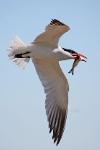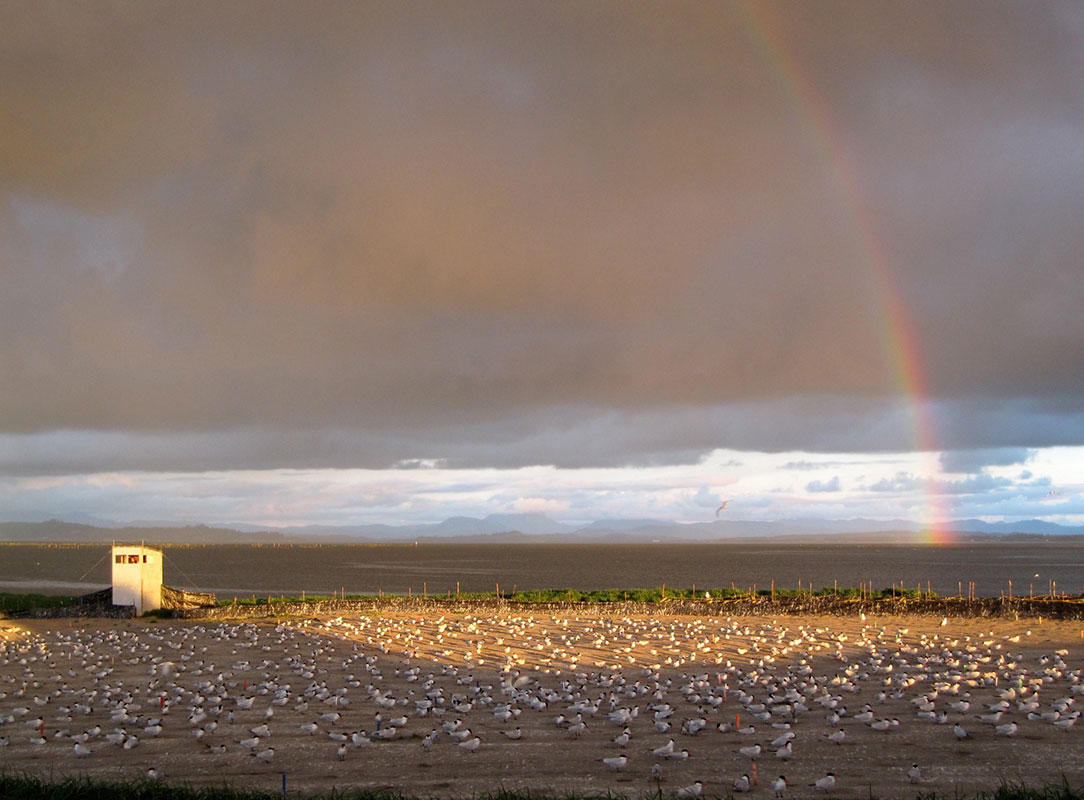 Tern Management on East Sand Island, 2016
Tern Management on East Sand Island, 2016
The primary objectives of this study in 2016 were to monitor, evaluate, and adaptively manage initiatives implemented to reduce the number of Caspian tern (Hydroprogne caspia) nesting on East Sand Island and, therefore, reduce tern predation rates on ESA-listed juvenile salmonids (Oncorhynchus spp.) in the Columbia River estuary. First, with guidance from resource managers, we prepared 1 acre of tern nesting habitat for terns to use on East Sand Island and attempted to prevent nesting by terns outside that designated nesting area. Second, we monitored tern nesting activity on East Sand Island and evaluated their predation rates on ESA-listed juvenile salmonids. Third, we evaluated movement rates of previously color-banded Caspian terns to and from the East Sand Island colony to assess the efficacy of management initiatives implemented to relocate nesting terns to sites outside the Columbia River basin. Lastly, we monitored the effects of Caspian tern management actions implemented on East Sand Island on the other colonial waterbirds that nest and roost on the island.
The management plan entitled, Caspian Tern Management to Reduce Predation of Juvenile Salmonids in the Columbia River Estuary was first implemented in 2008, and implementation continued in 2016. The objective of this plan is to reduce the size of Caspian tern colony on East Sand Island to 3,125 - 4,375 breeding pairs, while preventing Caspian terns from colonizing other sites in the Columbia River estuary. As part of this plan, we prepared 1.0 acre of suitable nesting habitat for Caspian terns on East Sand Island prior to the 2016 nesting season, the same area of nesting habitat that was provided for terns in 2015, and an 80% reduction in what was provided for terns on East Sand Island prior to implementation of the management plan. The estimate of Caspian tern colony size on the 1.0-acre designated colony area in 2016 was 5,215 breeding pairs (95% c.i. = 5,000 – 5,430 pairs), slightly lower than the colony size in 2015 (5,430 breeding pairs; 95% c.i. = 5,200 – 5,660 pairs), and about a 50% reduction from the peak size of the tern colony on East Sand Island (ca. 10,670 pairs), which occurred in 2008.
We attempted to limit tern nesting on East Sand Island to the 1.0-acre designated colony area using passive dissuasion (stakes, rope, and flagging) and active dissuasion (human hazing). A total of 5.1 acres of passive dissuasion was installed on East Sand Island prior to the 2016 nesting season, 2.4 acres of which was installed on the east end of the island near the Caspian tern colony. Intensive human hazing was implemented in areas where terns prospected for nest sites. Despite these efforts, two satellite tern colonies formed late in the 2016 nesting season, one adjacent to the main colony area on the upper beach and the other adjacent to a ring-billed gull (Larus delawarensis) colony at the northeast tip of the island. Combined, these two satellite tern colonies consisted of an additional 700 breeding pairs, when the size of the satellite colonies was at its peak. Thus, the estimated total number of Caspian terns that attempted to nest on East Sand Island in 2016 was 5,915 pairs (95% c.i. = 5,410 – 6,425 pairs), which was slightly lower than the total number of Caspian terns nesting on East Sand Island in 2015 (6,240 pairs).
In 2016, the average nesting density of Caspian terns in the 1-acre designated colony area on East Sand Island was 1.36 nests/m2, similar to the average nesting density in 2015 (1.32 nests/m2), and the highest average nesting density ever recorded for Caspian terns nesting on East Sand Island. The peak nesting density on the tern colony in 2016 was 1.50 nests/m2, the same as in 2015. These results suggest that Caspian tern nesting density on the designated colony area is approaching the maximum. Given the more than 30-year history of Caspian terns nesting in the Columbia River estuary, it is expected that some, perhaps most, terns will initially adapt to reductions in suitable nesting habitat on East Sand Island by nesting at higher densities and/or attempting to nest in other, sometimes marginal, nesting habitat on East Sand Island (e.g., upper beaches) and elsewhere in the Columbia River estuary (e.g., Rice Island). Efforts to reduce Caspian tern predation rates on juvenile salmonids in the Columbia River estuary to levels stipulated in the management plan will likely require that all Caspian terns nesting in the Columbia River estuary be restricted to just the designated colony area on East Sand Island, and that the area of designated Caspian tern nesting habitat be reduced to about two-thirds of an acre, thereby forcing terns displaced from East Sand Island to relocate to alternative colony sites outside the Columbia River estuary.
As was the case in 2015, Caspian terns nesting on East Sand Island in 2016 were relatively resilient to disturbances by bald eagles (Haliaeetus leucocephalus) and associated gull (Larus spp.) depredation of tern eggs and chicks. These limiting factors caused the Caspian tern colony on East Sand Island to fail or nearly fail during 2010-2012. In 2016, the Caspian tern colony on the 1-acre designated colony site produced about 2,870 fledglings (average of about 0.55 young raised/breeding pair; 95% c.i. = 0.38 – 0.61), similar to the average productivity during 2015 (0.63 young raised/breeding pair).
To assess the efficacy of management implemented to disperse Caspian terns from nest sites within the Columbia River basin to alternative colony sites outside the basin, we monitored Caspian tern movements by re-sighting terns previously banded with field-readable leg bands at colonies both inside and outside the basin. Most resighted Caspian terns exhibited site fidelity to the colony on East Sand Island in 2016, although some banded individuals dispersed to colonies in the Columbia Plateau region and in the Salish Sea region. Estimated numbers of Caspian terns that moved from the Corps-constructed alternative colony sites in interior Oregon and northeastern California to the Columbia River estuary and to the Columbia Plateau region were high in 2016, probably due to continued severe drought that has negatively affected tern nesting and foraging habitat in interior Oregon and northeastern California during 2014-2016.
Predation rates on specific populations of anadromous salmonids (ESUs/DPSs) by Caspian terns nesting on East Sand Island in 2016 were some of the lowest ever recorded, particularly predation rates on steelhead (O. mykiss) populations. For example, predation rates on Snake River steelhead in 2016 were 6.1% (95% credible interval = 4.8 – 8.8), compared with an average of 22.2% (95% CI = 20.3 – 24.8) observed prior to implementation of management to reduce the size of the tern colony on East Sand Island. Reductions in tern predation rates were commensurate with reductions in tern colony size, indicating that Caspian tern management actions to reduce tern nesting habitat on East Sand Island are resulting in lower average annual predation rates on salmonid smolts. Like predation rates measured in previous years, Caspian tern predation rates in 2016 were significantly higher on populations of steelhead (6.1 – 8.8%, depending on DPS) compared with populations of salmon (0.7 – 1.4%, depending on ESU). An investigation of variation in predation rates based on fish rear-type (hatchery, wild), out-migration history (in-river, transported), run-timing, and smolt abundance (density) indicated that multiple factors influence a fish’s susceptibility to tern predation; reflecting dynamic and complex predator-prey interactions in the Columbia River estuary.
To further reduce predation rates by Caspian terns nesting at East Sand Island on salmonid smolts in the Columbia River estuary, more Caspian terns will need to be relocated to colonies outside the estuary. Based on the size of the East Sand Island colony in 2016 (5,915 breeding pairs) relative to the target colony size stipulated in the Management Plan (3,125 – 4,375 breeding pairs), an additional 1,500 – 2,800 breeding pairs will need to be relocated outside the estuary. This will likely require an increased effort to prevent Caspian terns from nesting outside the designated 1-acre designated colony area on East Sand Island. The potential for the formation of satellite tern colonies on East Sand Island can be reduced by (1) installing pre-season passive dissuasion more strategically, (2) move the designated tern nesting habitat further from the beach, and (3) collect a limited number of tern eggs (under permit) at incipient satellite colonies. In addition, the designated colony area will need to be reduced to less than 1 acre of nesting habitat (ca. 0.67 acres) to meet the management objective for colony size stipulated in the Plan.
-Bird Research Northwest
Click here to see full report



